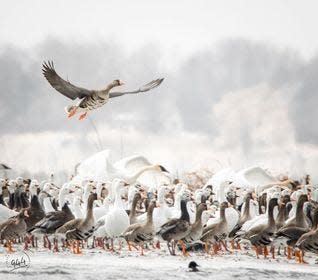Bird flu outbreak has slowed in 2023, but Iowa poultry producers remain fearful

Green lights bounce around Chad and Sheila Larson's turkey farm in north central Iowa, a laser array that represents an unusual approach to keeping geese and other waterfowl away from their operation after they lost about 26,000 birds to highly pathogenic avian influenza a year ago.
"We thought it was worth a try," Sheila Larson said. "And so far it's been great. We haven't seen geese land on our farm since we started."
Creative approaches, which also include wheeled drone vehicles that chase geese from potential nesting sites, are proliferating as the bird flu threat persists into a second year.
More: After rapid inflation in 2022, what will happen to food prices this year? Here's the USDA's forecast
Wild aquatic birds spread bird flu as they migrate across the country, infecting domestic poultry. The Larsons' turkey operation was one of 32 in Iowa, ranging from giant egg operations with millions of hens to small, backyard flocks, hit with the virus over the past year. Iowa producers destroyed nearly 16 million turkeys, chickens and other birds, the largest state toll among a total that reached 58.7 million birds at 817 farms nationwide.
The disease contributed to a 32% spike in egg prices last year, and the U.S. Department of Agriculture has forecast prices to climb nearly 38% this year.
The USDA estimates the outbreak ultimately will cost the agriculture sector $670 million, with $414 million going to help replace lost farm income and another $256 million to destroy birds exposed to the disease, dispose of their bodies and decontaminate the facilities.
More: Bird flu's grisly question: How to kill millions of chickens, turkeys to prevent the virus' spread
Larson said she and other farmers she talks with are nervous about getting hit with the virus again this year.
"It's changed enough; it's strong enough to survive," she said. "It's part of our world now."
Keeping wild birds from poultry farms helps, though virus can spread through other means
Luckily, the outbreaks so far have been less widespread than at this time last year, state and federal officials say.
In March 2022, for example, bird flu hit 51 U.S. commercial poultry operations, while just seven facilities were hit last month. In Iowa, the nation's largest egg producer and seventh-largest turkey producer, the virus affected 10 commercial chicken and turkey operations in March 2022, but none last month.
Still, Iowa and the U.S. have a lot of highly pathogenic avian influenza floating around, said Yuko Sato, an Iowa State University veterinarian. In 2015, the U.S. detected the virus in fewer than 100 wild birds. Over the past year, that number grew to nearly 6,500.
"The virus is everywhere, so there's just a higher chance that wild birds are carrying the virus," Sato said.
More: Tripled egg prices giving owner of popular Des Moines diner indigestion
Tighter biosecurity has helped. During the previous record bird flu outbreak in the U.S. and Iowa in 2015, about 70% of the cases were lateral infections, carried from one barn to another, Sato said. This time, it's less than 15%.
But she said a producer could bring in the virus or it could be carried on the wind or rain.
The potential sources of infection broaden even more as USDA researchers detect mammals carrying the virus, said Larson, the Ellsworth turkey farmer.
A year ago: Here's why protests at Minnesota Timberwolves games are tied to an Iowa chicken farm, bird flu
"We were doing everything we thought we could when we were infected," like keeping dedicated equipment at each barn, allowing no boots, coveralls or tools from outside the facility, and limiting who can come on the farm, she said. "And now, we've added lasers to see if that makes a difference."
Donnelle Eller covers agriculture, the environment and energy for the Register. Reach her at deller@registermedia.com or 515-284-8457.
This article originally appeared on Des Moines Register: Bird flu outbreak has slowed in 2023, but egg prices expected to rise
